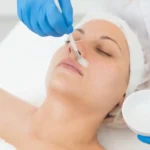
Patients with scarring from acne usually desire a way to improve the look of their scars, particularly if they are on their face. While the treatment of acne scarring is strictly cosmetic, diminishing the appearance of these scars can result in great improvements to the patient’s psychological and emotional well-being, and can profoundly impact their self-image.Acne scars are usually a result of nodular and cystic acne, and are caused by atypical healing following inflammation, where enzymatic and inflammatory mediators cause a localized breakdown of subcutaneous fat and collagen.
Treating acne scars with Restylane injections
For the aesthetic practitioner, treating acne scarring can be challenging, as not all scars may respond in the same way, or at all, to a generalised therapeutic approach. It is therefore important that the treatment be tailored to the individual based on their specific needs. There are currently many different modalities of treatments available for the treatment of acne scarring. Including chemical peels, radiofrequency and laser treatments, dermabrasion, needling, and soft tissue fillers. While each of these treatments has its own advantages and shortcomings, only the last treatment type will be discussed in detail in this article.
Types of acne scars
Dermal fillers help to lessen acne scarring by lifting out the area underneath individual scars through tissue augmentation. Due to this approach, the type of scar is important to note: not all scars can be treated with injectable fillers. There are three types of acne scars: atrophic scars, keloidal scars, and hypertrophic scars. Dermal fillers can only work on atrophic scars, which are scars with pitting or indents. Atrophic scars can be further divided into types based on the indent shape: ice pick, boxcar and rolling. Of these subcategories, soft tissue fillers are most effective in treating rolling scars.
Hyaluronic acid dermal fillers are the tissue augmenting agent of choice, because they offer relatively durable results with a decreased risk of hypersensitive and immunogenic reactions. A popular dermal filler brand that has been used widely for this purpose is Restylane. As one of the first dermal fillers to appear on the market, Restylane has a long track record when it comes to the safety and efficacy of its products. When it comes to acne scarring, Restylane Refyne (previously Emervel Classic) works wonders for filling individual scars, while the fine particles in Restylane Silk are perfect for the treatment of larger areas of scarring.
Tips for professionals:
When injecting Restylane for acne scarring, practitioners must approach the treatment area in a methodical fashion, as localized edema may make it harder to visualize the scars as treatment progresses. Additionally, they should ensure that product placement is not too deep, as this will result in less visible effects, or too shallow, as this could cause complications like lumps, nodules and visible filler.
Aftercare for Restylane for acne scars
After Restylane treatment, the patient can expect to experience swelling, bruising, bleeding and tenderness at the injection site. These can be managed through certain post-treatment measures, such as refraining from alcohol use 24 hours post-injection and limiting sun and heat exposure for one week after treatment. As well, the patient should be advised to massage the treated area so as to minimize the likelihood of lumps or nodules.
All in all, Restylane is a safe and effective treatment for the reduction of atrophic scarring. With immediate results that are noticeable and relatively long-lasting, this treatment can provide great psychological benefit to patients afflicted with this condition.
Aesthetic medicine products are developed and regulated to meet stringent safety and efficacy standards. They are typically administered by trained healthcare professionals such as dermatologists, plastic surgeons, and specialized nurses in clinical settings. These products aim to provide effective solutions for cosmetic enhancement, skin rejuvenation, and overall aesthetic improvement, contributing to both physical appearance and self-confidence.
Key categories of aesthetic medicine products include:
-
Injectables: This category includes products such as dermal fillers, botulinum toxins (e.g., Botox), and collagen stimulators. These injectables are used to smooth wrinkles, add volume, and improve facial contours.
-
Skin Rejuvenation Treatments: Products like chemical peels, microdermabrasion systems, and laser devices are used to improve skin texture, reduce pigmentation irregularities, and enhance overall skin tone.
-
Skincare Products: These include medical-grade cleansers, moisturizers, serums, and topical treatments containing active ingredients like retinoids, antioxidants, and growth factors. They are formulated to address specific skin concerns such as acne, aging, and hyperpigmentation.
-
Hair Restoration Products: Medical treatments and products designed to promote hair growth and treat conditions such as male and female pattern baldness.
-
Body Contouring and Fat Reduction: Devices and products used for non-surgical body sculpting, such as cryolipolysis (cool sculpting) devices and injectable lipolytics.
-
Cosmeceuticals: High-performance skincare products that bridge the gap between cosmetics and pharmaceuticals, often containing potent ingredients with proven clinical benefits.
-
Wound Care and Scar Management: Products like silicone sheets, gels, and advanced wound dressings used to improve healing and reduce the appearance of scars.





